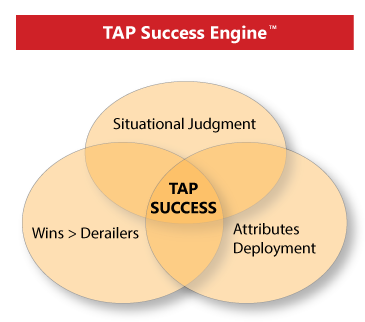Perhaps it’s your first time as a people manager or you’ve taken leadership of a new department, or a position at a new company. These examples of professional transitions, either simple or complex, all offer a unique opportunity to showcase your leadership skills and accelerate your growth.
I’ve had the privilege of facilitating and coaching dozens of professionals and executives using the Transition Acceleration Program, or “TAP.” Through these sessions, I’ve discovered key success factors in a variety of transitional situations. These practices led me to create the “TAP Success Engine” as a model to help fuel my client’s growth.

The TAP Success Engine provides:
- Situational analysis – for a full understanding of transition success.
- Clear desired outcome – by daring to “dream the possible.”
- Identification of quick wins and potential derailers – to advance a successful transition.
- Assessment of attributes – the skills, knowledge and abilities, as well as, weaknesses, that will most likely come into play as a result of the transition.
- Quick implementation – to establish a blueprint for success.
I’ve developed an easy-to-use question based template to first assess the components of this model, then create and implement a plan for transitions including: promotions to a new position, leading a new project, learning a new skill, adapting to new situations, etc. I’ve found it most beneficial to complete the template before I begin a new transition so that the answers can serve to frame the opportunity from the outset.
Step 1 – “Identify the Exact Transition”
Prepare crisp, concise responses to the following questions:
- What expectations (from your boss or others) of success have been shared with you thus far?
- What is changing for you as a result of this transition?
- What is not changing?
- Who else do you need to talk with (key stakeholders impacted by your success/failure) to validate, clarify or enhance these expectations?
Step 2 – “Dare to Dream the Possible”
Envision success before it happens.
- Imagine that you have already completed this transition, successfully exceeding all expectations. What would it feel like to accomplish this goal? How would you know you have achieved this level of success? What would be different?
- Identify 3-6 major milestones or “wins” needed for your desired outcome this to become a reality?
Step 3 – “Contemplating the ‘ifs’ ”
Before completing your plan’s action steps, ask yourself these questions:
- What new skills, tasks, or responsibilities might I be asked to use for the first time as a result of this transition?
- Which of my existing strengths will I rely on? What can I do to make sure they come into play?
- What might cause a “derailment” (personal weaknesses, past experiences in similar transitions) in my process? How might I address that?
- What can be done to make sure these derailers don’t come into play?
- Whose help do I need to achieve my desired outcome?
Step 4 – “Populate Your Plan”
For each major milestone, identify the key action steps needed to achieve this milestone, keeping in mind your responses in step 3.
I sincerely hope that you find this article and its contents of help to you in becoming your best self.
Tad Dwyer, M.Ed.
